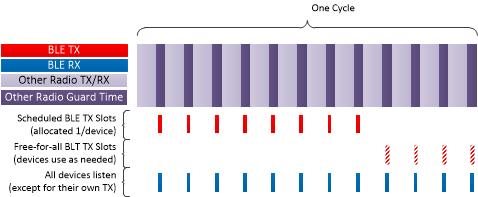Our device using nRF52840 is running an external (non-BT) radio most of the time. We need to send and receive data In between operations of this other radio. At any given time, there will be one sender and multiple receivers. Since there will be no BLE connection or interaction, this is essentially a beacon operation except for the scheduling. We are trying to understand if it is possible to manually send and receive without running a BLE schedule and without any interaction between sender and receiver.
We are assuming/hoping this will be possible using L2CAP functions instead of GAP/GATT functions and never starting any GATT scheduling. However the L2CAP message sequence charts in SD140 v7.0.1 all show two-way communication.
Please clarify how the scheme described here can be accomplished.
The overall schedule will be something like
Receive-only devices:
- Receive other radio
- Receive BLE (20-40ms interval)
- (repeat steps 1 & 2 indefinitely)
Receive/Transmit devices:
- Receive other radio
- Receive BLE (20-40ms interval)
- (repeat steps 1 & 2 N times)
- Transmit other radio
- Transmit BLE
- (repeat steps 1 - 5 indefinitely)



